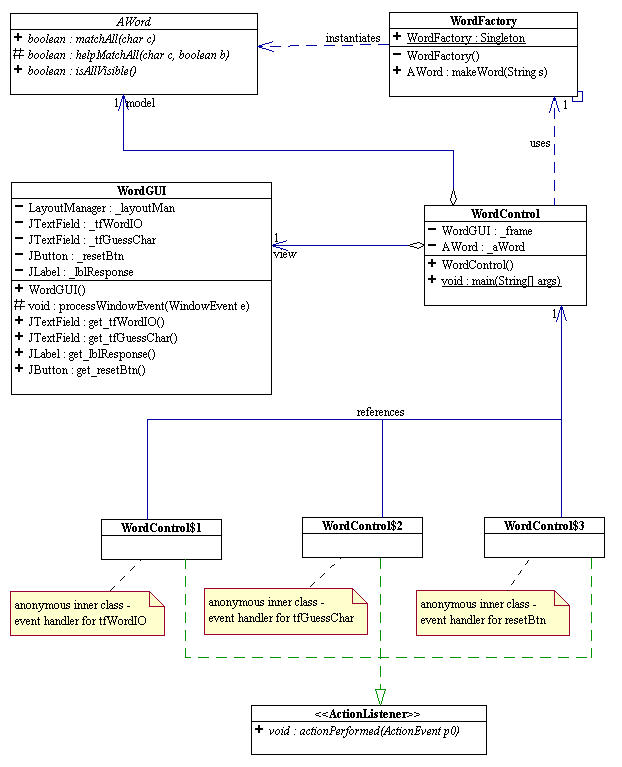
This tutorial covers:
Create your own copy of this lab's code, e.g.,
cp -r ~comp212/public_html/01-spring/labs/05/ ....
This contains the Java byte code and some of the source code
for a GUI application
that can be used to test the classes required for milestone #1 of the
Hangman project.
Note that we have not provided all of the source code, because that
would be completing milestone #3 for you.
To see how the application behaves, run the command:
java WordTest/WordControl
A window called the view should appear.
This window has input/output text
field at the top, an input textfield at the bottom, a reset button
at the right, and an output label field at the left.
It is implemented as the class WordGUI.
You can play a game of Hangman, e.g.,
Type the word hello in the top text field and hit
enter. The is a sample word to be guessed (e.g., by another person).
The input text becomes _ _ _ _ _.
Type the letter l in the bottom text field and hit
enter. The top text field should display _ _ l l _ ,
and the output label field should display Good
Guess!.
(This demo does not draw a body.)
Erase the letter l in the bottom text field, type
the letter a, and hit enter. The top text field
should display _ _ l l _ , and the output label field
should display Wrong Guess!.
Erase the letter a in
the bottom text field, type the letter h, and hit enter.
The top text field should display h _ l l _ , and
the output label field should display Good Guess!.
You can finish the game if you wish.
The object that does all the checking of the guesses is called the
model.
It is represented by the class AWord,
its concrete subclasses, and supporting classes.
When a user types a guess letter in the bottom text field and hits
the enter key, the Java virtual machine creates an appropriate "event"
and delivers it to this text field. This text field is
programmed to respond to this event by first inquiring the
AWord model to match the guess and then updating
the other GUI component accordingly.
The wiring between a GUI component and the model is called a
control. The class WordControl establishes
all the controls to wire the GUI view to the AWord
model. The design of this small GUI application is fashioned
according what is commonly known as the Model-View-Control (MVC)
paradigm, as illustrated below.

The design consists of several pieces:
The WordFactory class is not part of the MVC design.
It is a factory to manufacture concrete instances of
AWord.
The view (WordGUI) knows nothing about the model.
It has several GUI components (e.g.,
JTextField and JButton)
and exposes them to the outside world via appropriate getter methods
(e.g., get_tfWord, get_resetBtn).
The model (AWord, NonEmptyWord,
and EmptyWord) knows nothing about the view.
It has only the intelligence to match a character
and to tell whether or not the player is a winner.
The control (WordControl)
connects the GUI to the model by installing ActionListener
objects for each GUI component of the view that needs to respond
to an external event.
These ActionListener objects are usually
implemented as inner classes in Java.
For a GUI component to respond to an event,
you must attach to it an appropriate event
listener object. ActionListener is a special kind of
event listener that is associated with GUI components such as
JTextField and JButton.
You attach an ActionListener to a GUI
component by calling addActionListener(...) on the GUI
component. The following code fragment for the constructor of
WordControl
illustrates the attachment of event listeners to GUI components.
public WordControl()
{
// Add controller for hangman word input/output
_frame.get_tfWordIO().addActionListener(
new java.awt.event.ActionListener()
{
public void actionPerformed (ActionEvent e)
{
_aWord = WordFactory.Singleton.makeWord(_frame.get_tfWordIO().getText());
_frame.get_tfWordIO().setText(_aWord.toString());
_frame.get_tfWordIO().setEditable(false);
}
}
);
// more stuff...
}
ActionListener is an interface.
As we've seen beforce, that means it is a special kind of abstract
class with no method code bodies and no non-static fields
It has one (abstract) method:
public void actionPerformed(ActionEvent e)
A concrete ActionListener must have code for this method,
as in the above example.
This method will be executed when an ActionEvent
is created and delivered to the corresponding GUI component.
So, whenever a text is entered into the top text field,
_frame.get_tfWordIO(), its
ActionListener object
will execute its actionPerformed method.
This ActionListener object is created in a very special
way here -- it does not have a name and exists only in the context of an
instance of WordControl!
It is called an anonymous inner class of class
WordControl. In the above diagram, the anonymous event
listener/handler for the top text field is labeled WordControl$1.
Each inner class object has a reference to its outer object
WordControl.
The following is a summary of how to design a GUI application in Java using the MVC paradigm:
Design a GUI and expose appropriate GUI components with
getter methods (e.g., WordGUI).
Exercise: Work on this in lab.
The standard approach to build a window is to subclass
JFrame. The labbies will help you complete
the construction of the frame.
Also, we will soon have a special tutorial covering Swing, the
Java GUI library.
This is a substantial part of milestone #3 of the hangman project.
Design the model with appropriate intelligence to solve
the problem at hand (e.g., AWord
and its concrete variants).
You are implementing this for milestone #1 of the hangman project.
Design a controller to instantiate views and models, and attach event
listeners to appropriate GUI components in order to wire the view
to the model (e.g., WordControl).
Exercise: Work on this in lab. The labbies will help you complete the code for the listener to the bottom text field where your guess is entered.
This is a substantial part of milestone #3 of the hangman project.